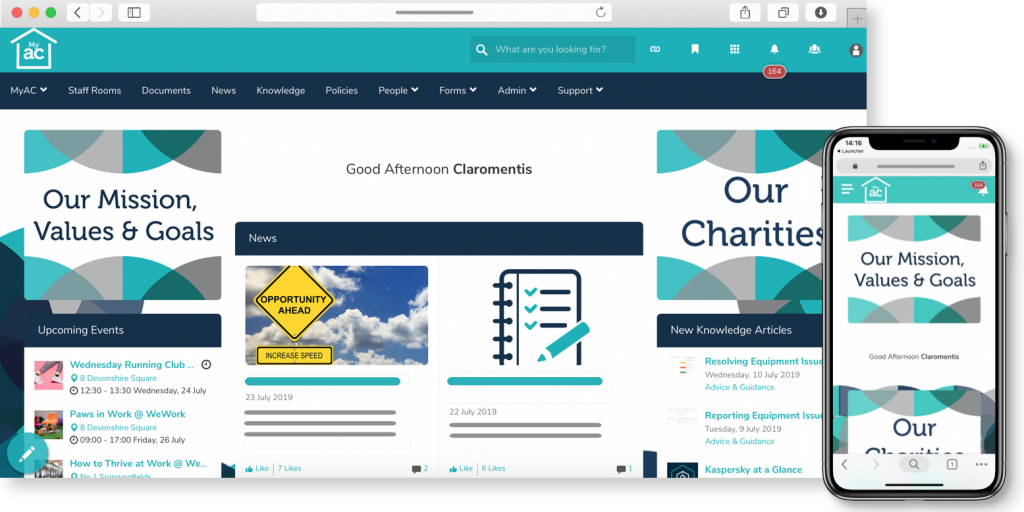I was reading an interesting article recently that gave me food for thought about today’s company intranets and their place in a typical 21st century organisation.
This article was about someone who had won a computer – back when the technology was brand new – and they had no idea what to do with it. A friend duly showed up, and gave them a demo of this magical new device.
However, the demo fell flat. The computer winner had never even used a typewriter, and so couldn’t see any reason why they should replace a machine they didn’t own in the first place with something newer.
This got me thinking about present day business leaders who aren’t sure why they need a modern intranet. In my experience, they tend to fall into the same few groups:
1. Those who don’t have an intranet solution at all.
In my experience, business leaders in this position tend to see company intranets as a box-ticking exercise. Lists of features are prioritised over meaningful goals such as boosting employee engagement, improving company culture, or increasing communication and collaboration.
2. Those who built a company intranet themselves, but it’s out of date and needs replacing.
This is a common pitfall of buil , c 456u7ding your own intranet. Digital workplace technology is constantly evolving, so relying on an in-house team to keep up to date with the latest developments is a tall order.
It’s also expensive. Utilising the latest and greatest tech to ensure your proprietary system is user friendly, easily accessible, and fulfils all the criteria of an engaging user experience – not to mention the server and storage space needed to host it – comes with a hefty price tag.
3. And those who have an out-of-the-box intranet but no one likes using it.
In these situations, business leaders have implemented an engaging company intranet with all the best intentions – but for reasons aplenty, the project has stalled. Perhaps the software doesn’t provide the employee experience that team members were hoping for, or the intranet design is lacking and the communication tools are unintuitive.
In a nutshell, it’s likely that the company intranet just doesn’t reflect the needs of your teams.
So – are intranets dead?
Absolutely not!
The issue at play here is misapprehension. Just like the confused computer competition winner, what’s holding some businesses back from realising the technology’s true potential is a misunderstanding of how it works, why it’s important, and how it benefits the organisation’s goals.
There’s often a misconception about what an intranet actually is. An intranet is not just a social networking platform with bells on, nor is it a static site for holding company documents.
Modern company intranets – which often form part of a wider digital workplace – work wonders for organisations when used effectively and with full understanding of what the technology achieves.
And on that note, here’s an at-a-glance summary of the benefits of today’s company intranet software:
A few benefits of the new company intranet
Improve internal communications
Forget what you think you know about intranet communication tools. They’re not one-sided and nor are they distributed to the masses without any thought to relevance.
Intranets of today include content targeting tools that allow you to specify which teams or individuals to share company communications with. This keeps internal communications relevant at all times – teams will only see what’s relevant to their role or department, which will reduce content overload.
Social media-inspired tools such as “likes”, @mention tagging, and comments also allow teams to interact with news articles by posting feedback or asking questions. This is a key element to improving internal comms, because it enables two-way conversations by inviting staff to share their thoughts.
Boost employee recognition and motivation
Modern intranets are full of features that make it easy to recognise employee achievements, which in turn boost motivation levels.
For instance, intranet badges allow managers or coworkers to award staff whenever they do a good piece of work, complete a training course, or are simply helpful and supportive. Meaningful and genuine recognition like this is a powerful motivator.
Increase knowledge sharing
Tools such as document management and knowledge bases are long-standing staples of intranet software, but that doesn’t mean they’re any less valuable.
On the contrary, they’re essential to creating a knowledgeable workforce. These apps make it simpler for teams to find up-to-the-minute information thanks to version-control and easy access. And when increasing your company’s knowledge leads to business growth, it’s no wonder that these apps still remain a prominent feature in today’s company intranets.



